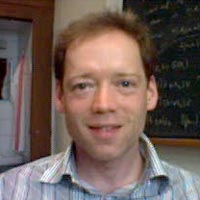Workshop on QUANTUM INFORMATION PROCESSING AND QUANTUM COMMUNICATIONS
Quantum Information Processing and Quantum Communications
On the structure of Clifford quantum cellular automata
>VITAE:
1987-1996: Study in Physics at the University
of Hamburg (Germany), Diploma and PhD in the field of "algebraic
quantum field theory" at the II. Institute for Theoretical Physics
in the group of Klaus Fredenhagen.
1997-1999: Research project in quantum field
theory an euclidean field theory at the Erwin Schrödinger International
Institute for Mathematical Physics (ESI), Vienna associated with the group
of Jakob Yngvason at the Institut für Theoretische Physik, University
Vienna. Funding by the DFG, the ESI and the Jubiläumsfonds der Oesterreichischen
Nationalbank.
Since 2000: Research associate at the Institut
für Mathematische Physik, Technical University Braunschweig, in the
quantum information theory research group of Reinhard Werner. Funding
by the DFG and EQUIP.

In particular, the model of a one way-quantum computer (by Robert Raussendorf and Hans Briegel) is based on the application of a quantum cellular automata to a system of qubits which occupy the sites of a two-dimensional cubic lattice. The concept of a quantum cellular automaton (QCA) is introduced from an C*-algebraic point of view. The observable algebra of the underlying system is modeled the tensor product of a finite dimensional matrix algebra over an infinitely extended regular lattice. A QCA is given by an automorphism which commutes with the spatial translations and which maps the algebra at a given position into the tensor product of next neighbors (local transition rule). We are concerned with a particular class of so called Clifford QCAs: The matrix algebra at each position of the lattice is generated by a discrete Weyl system, i.e. the analog of the pauli operators including non-binary systems. The QCA under consideration maps "Weyl operators" onto multiples of Weyl operators. For example, the QCA which is used for the implementation of a one-way quantum computer is of Clifford type. Clifford QCAs are induced by symplectic transformations implementing the local transition rule. We discuss the structure of Clifford QCAs by characterizing those symplectic transformations which lead to a well defined automata.